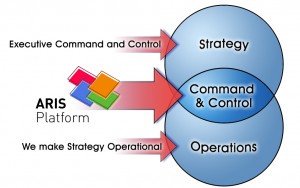 In order to provide today’s operationally savvy executive with the command-and-control cockpit that is needed to run an effective organization, I propose that we must first consider the three basic components that are the foundation of any organization: people, processes and technology. In order to achieve the lofty goals of increased valuation, top-line growth and increased share price, it is imperative to have a well-defined business strategy, supported by a sound operational strategy, which is driven by operational execution. It is this foundation that provides the fuel to drive operational execution.
In order to provide today’s operationally savvy executive with the command-and-control cockpit that is needed to run an effective organization, I propose that we must first consider the three basic components that are the foundation of any organization: people, processes and technology. In order to achieve the lofty goals of increased valuation, top-line growth and increased share price, it is imperative to have a well-defined business strategy, supported by a sound operational strategy, which is driven by operational execution. It is this foundation that provides the fuel to drive operational execution.
But here’s the rub, I have discovered that two thirds of this foundation is fluid. Technology is in a constant state of change. Enabling and disruptive technologies are continually introduced into the infrastructure. System upgrades and application consolidation force changes to happen on critical production systems. People are coming and going and cost factors are driving outsourcing, off-shoring, and near-shoring.
The only piece of the foundation that is 100% in management’s control is the processes. So, how can you continue to create value and establish a culture of continuous improvement with a shifting foundation?
My point of view is that a repository of business processes serves as the corporate memory and provides insulation against the threat of knowledge-loss due to turnover and outsourcing.
I suggest that the answer is to gain control of your processes. Control means assurance of process performance, and conformance to process standards. Reducing variability of process behavior is a key to controlling cost and producing predictable results. In order to gain command-and-control we must start with visibility and accountability. Exposing the behavior of your most important corporate asset, your business processes, and the effect that processes have on driving outcomes provides the operational executive with their best weapon to proactively manage key corporate indicators. Constant monitoring and analysis of process performance and process behavior enable the management of accountability rather than reaction to crisis. With visibility comes accountability. With accountability comes responsibility.
 Analysis of discreet data events without the benefit of a business process context cannot provide the information needed to drive an enterprise to operational excellence. Individual transactions cannot provide a complete process outcome. I have seen that, only by experiencing the entire flow of a business process and the measurement across and within the discreet process steps can you begin to gain the level of introspection necessary to drive true optimization. And, only by gathering each instance of a flow through an end-to-end process can you provide complete analytical capabilities to understand influencing factors based on process deviations and their associated costs, quality, cycle times, and other process-oriented key performance indicators. It is clear that a robust, performance measurement framework must be established from the business process perspective. Through this framework, actual executed processes can be discovered, process performance evaluated, and process conformance analyzed. These are the elements that lead to process optimization, predictable behavioral results and yield an agile enterprise.
Analysis of discreet data events without the benefit of a business process context cannot provide the information needed to drive an enterprise to operational excellence. Individual transactions cannot provide a complete process outcome. I have seen that, only by experiencing the entire flow of a business process and the measurement across and within the discreet process steps can you begin to gain the level of introspection necessary to drive true optimization. And, only by gathering each instance of a flow through an end-to-end process can you provide complete analytical capabilities to understand influencing factors based on process deviations and their associated costs, quality, cycle times, and other process-oriented key performance indicators. It is clear that a robust, performance measurement framework must be established from the business process perspective. Through this framework, actual executed processes can be discovered, process performance evaluated, and process conformance analyzed. These are the elements that lead to process optimization, predictable behavioral results and yield an agile enterprise.
Read more about Process Intelligence: www.aris.com/ppm


Ricardo Seguel P. on
I agree with your point of view by gaining control in your processes you can keep corporate memory. Nevertheless, as technology is constantly changing imply changes into processes and people knowledge in high competitive enterprises today. Regard to these constant changes, controls must be sufficiently flexible to avoid overhead and extra spending money. For instance, a growing company that uses a spreadsheet to register incoming and outgoing items and spare parts from storage and have a procedure to authorize that by a supervisor’s sign, then company decides change to a centralized system to track items with ability to add RFID in a near future. Well, in this case obviously you don’t need a supervisor’s sign as you have a lot of possible controls to add and replace in. What happens if a manager decides to keep related control by supervisor’s sign? On another hand, what happens if doesn’t use supervisor’s sign but e-mail authorization? and with digital signature? etc.? Indeed, this technological change affects whole supply change process and people involved, also KPI’s. So a PPM framework could leads process optimization, but for that you need redesign the process and update KPI’s with a good change management.
Best regards,
Ricardo Seguel P.